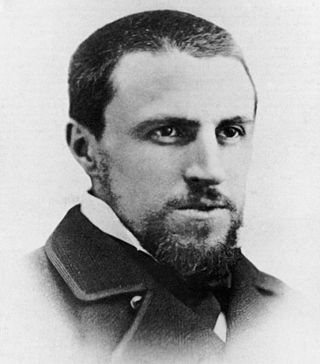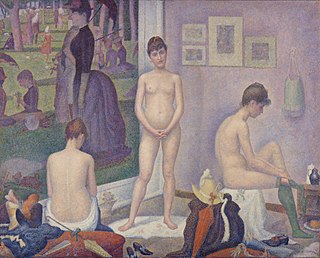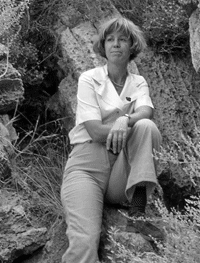Related Research Articles

Impressionism was a 19th-century art movement characterized by relatively small, thin, yet visible brush strokes, open composition, emphasis on accurate depiction of light in its changing qualities, ordinary subject matter, unusual visual angles, and inclusion of movement as a crucial element of human perception and experience. Impressionism originated with a group of Paris-based artists whose independent exhibitions brought them to prominence during the 1870s and 1880s.

Gustave Caillebotte was a French painter who was a member and patron of the Impressionists, although he painted in a more realistic manner than many others in the group. Caillebotte was known for his early interest in photography as an art form.

Neo-Impressionism is a term coined by French art critic Félix Fénéon in 1886 to describe an art movement founded by Georges Seurat. Seurat's most renowned masterpiece, A Sunday Afternoon on the Island of La Grande Jatte, marked the beginning of this movement when it first made its appearance at an exhibition of the Société des Artistes Indépendants in Paris. Around this time, the peak of France's modern era emerged and many painters were in search of new methods. Followers of Neo-Impressionism, in particular, were drawn to modern urban scenes as well as landscapes and seashores. Science-based interpretation of lines and colors influenced Neo-Impressionists' characterization of their own contemporary art. The Pointillist and Divisionist techniques are often mentioned in this context, because they were the dominant techniques in the beginning of the Neo-Impressionist movement.
Faith Wilding is a Paraguayan American multidisciplinary artist - which includes but is not limited to: watercolor, performance art, writing, crocheting, knitting, weaving, and digital art. She is also an author, educator, and activist widely known for her contribution to the progressive development of feminist art. She also fights for ecofeminism, genetics, cyberfeminism, and reproductive rights. Wilding is Professor Emerita of performance art at the School of the Art Institute of Chicago.

The feminist art movement in the United States began in the early 1970s and sought to promote the study, creation, understanding and promotion of women's art. First-generation feminist artists include Judy Chicago, Miriam Schapiro, Suzanne Lacy, Judith Bernstein, Sheila de Bretteville, Mary Beth Edelson, Carolee Schneeman, Rachel Rosenthal, and many other women. They were part of the Feminist art movement in the United States in the early 1970s to develop feminist writing and art. The movement spread quickly through museum protests in both New York and Los Angeles, via an early network called W.E.B. that disseminated news of feminist art activities from 1971 to 1973 in a nationally circulated newsletter, and at conferences such as the West Coast Women's Artists Conference held at California Institute of the Arts and the Conference of Women in the Visual Arts, at the Corcoran School of Art in Washington, D.C..

Paris Street; Rainy Day is a large 1877 oil painting by the French artist Gustave Caillebotte (1848–1894), and is his best known work. It shows a number of individuals walking through the Place de Dublin, then known as the Carrefour de Moscou, at an intersection to the east of the Gare Saint-Lazare in north Paris. Although Caillebotte was a friend and patron of many of the impressionist painters, and this work is part of that school, it differs in its realism and reliance on line rather than broad brush strokes.

Les raboteurs de parquet is an oil painting by French Impressionist Gustave Caillebotte. The canvas measures 102 by 146.5 centimetres. It was originally given by Caillebotte's family in 1894 to the Musée du Luxembourg, then transferred to the Musée du Louvre in 1929. In 1947, it was moved to the Galerie nationale du Jeu de Paume, and in 1986, it was transferred again to the Musée d'Orsay in Paris, where it is currently displayed.
Nancy Angelo is an organizational psychologist and formerly a performance and video artist who took part in the feminist art movement in Los Angeles. As an artist, she is best known for co-founding the collaborative performance art group The Feminist Art Workers in 1976 with Candace Compton, Cheri Gaulke, and Laurel Klick.

Le Pont de l'Europe is an oil painting by French impressionist Gustave Caillebotte completed in 1876. It is held by the Musée du Petit Palais in Geneva, Switzerland. The finished canvas measures 125 by 181 centimetres.

Homme au bain is an 1884 oil painting by French Impressionist Gustave Caillebotte.
Mary DuBose Garrard is an American art historian and emerita professor at American University. She is recognized as "one of the founders of feminist art theory" and is particularly known for her work on the Baroque painter Artemisia Gentileschi.
Alessandra Comini is an American art historian and curator. She is University Distinguished Professor of Art History Emerita at Southern Methodist University in University Park, Texas. Proficient in music and languages as well as art history, Comini brought an interdisciplinary approach to her study of the arts in Austria and Germany at the turn of the 20th century, an approach particularly suited to the integrated art forms of fin-de-siècle Vienna.
This is an ongoing bibliography of work related to the Italian baroque painter Artemisia Gentileschi.
Carol Greene Duncan is a Marxist-feminist scholar known as a pioneer of ‘new art history’, a social-political approach to art, who is recognized for her work in the field of Museum Studies, particularly her inquiries into the role that museums play in defining cultural identity.

Models, also known as The Three Models and Les Poseuses, is a work by Georges Seurat, painted between 1886 and 1888 and held by the Barnes Foundation in Philadelphia. Models was exhibited at the fourth Salon des Indépendants in spring of 1888.
Judith Kapstein Brodsky is an American artist, curator, and author known for her contributions to feminist discourse in the arts. She received her B.A. from Harvard University where she majored in Art History, and an M.F.A. from Tyler School of Art at Temple University. She is Professor Emerita in the Department of Visual Arts at Rutgers, State University of New Jersey. A printmaker herself, Brodsky is founding Director of the Rutgers Center for Innovative Print and Paper in 1996, later renamed the Brodsky Center in her honor in September 2006, and which later joined the Philadelphia Academy of Fine Arts (PAFA) in 2018. She was also co-founder, with Ferris Olin, of the Center for Women in the Arts and Humanities at Rutgers University in 2006. She was the first artist appointed as president of the Women's Caucus for Art, an active Affiliated Society of the College Art Association.
Jacqueline Skiles is an American artist. She was a member of Women Artists in Revolution (WAR) and participated in the group's demand that the Whitney Museum include more women in its annual exhibitions. She also directed a graphics and silk-screen workshop at the Women's Interart Center.

Maude Boltz (1939-2017) was an American artist and co-founder of the A.I.R. Gallery.

The Tea, also referred to as Five O’Clock Tea, is an oil-on-canvas painting of two women having tea by the American Impressionist painter Mary Cassatt. The role of gender in the painting has been the subject of differing interpretations among art historians. Griselda Pollock describes the confined interior as an evocation of the spatial and social constraints placed on women at the time. Norma Broude asks whether the work might contain "possibilities for empowerment," showing the agency that women exercised through sociability. And John Loughery argues that the intention behind Cassatt's work might always remain a mystery.
References
- ↑ "Norma Broude". Dictionary of Art Historians. Retrieved 2017-05-02.
- ↑ "Profile Norma Broude". American University. Retrieved 2017-05-02.
- ↑ "Brief Bios: Norma Broude and Mary D. Garrard". Feminist Art History Conference 2010. American University. Retrieved 2 May 2017.
- ↑ "Awards for Distinction". College Art Association (CAA). Retrieved 2017-05-02.
- ↑ Haynes, Clarity (2015-03-14). "How We Got Here: Portrait of the Artist as a Queer Feminist". Hyperallergic Magazine. Retrieved 2017-05-02.